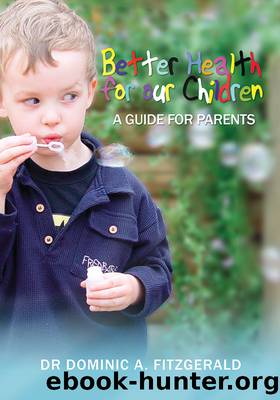Better Health for our Children by Fitzgerald Dominic A.;

Author:Fitzgerald, Dominic A.;
Language: eng
Format: epub
Publisher: Clareville Press
Chapter 13
Urinary Tract Infections
Key Points
⢠Fever is the best predictor of a urinary tract infection in a young child with no obvious site of infection.
⢠Predisposing factors for urinary tract infection in otherwise well children relate to age, gender and anatomy.
⢠The once popular practice of using long term once daily antibiotics to prevent recurring urinary tract infections is contentious.
INTRODUCTION
Urinary tract infections [UTIs] present commonly in young children with fever and a variety of non-specific symptoms. The diagnosis of a UTI should be entertained in all young children with a fever and no obvious focus of infection. In order to make an accurate diagnosis of UTI a mid-stream or clean catch urine specimen should be obtained in children of all ages before antibiotic treatment is commenced.
Who gets UTIs and why?
UTIs are common in children, occurring in about 1:650 neonates. There is a slight male preponderance in very young infants. Beyond 4-6 weeks of age there is a marked female preponderance. UTIs are seen frequently in the toddler age group, but the prevalence is thought to peak in school aged girls where up to 2.5 per cent of girls may be affected.
Predisposing factors for a UTI in otherwise well children relate to age, gender and anatomy. Colonic bacteria are the most common cause of UTIs. The method of cleaning a young childâs bottom after defaecation [i.e. not wiping from front to back] is suggested to be important.
In children with underlying chronic renal failure, one must always consider the possibility that the occurrence of a UTI has precipitated a deterioration in renal function, most commonly measured by a rise in the blood urea or creatinine or change in the findings on urinalysis. Similarly, immunocompromised children are at increased risk of a UTI. These children may or may not have specific symptoms.
Presenting features of UTIs
In young infants, a child may present with fever and no obvious focus of infection. A clean-catch, mid-stream or catheter urine specimen is essential. Young infants may have lethargy, weight loss, failure to thrive, nausea, vomiting, diarrhea and jaundice as the result of a UTI.
Older children more often present with symptoms referable to the urinary tract together with fever. Urinary frequency, nocturia, incontinence, dysuria and abdominal pain may be reported or observed by parents. Abdominal pain may occur.
Management of UTIs: Home or hospital?
Who should receive intravenous antibiotics as initial therapy for a UTI? There is no consensus on this, although studies that have addressed this issue have often excluded younger children [< 3 months] from enrolment. One study which examined this in children under 2 years of age with a first UTI confirmed on a catheter urine specimen excluded 7 patients as they were too unwell and gave them intravenous therapy! The study found no difference between 14 days of oral antibiotics and three days of intravenous antibiotics followed by 11 days of oral antibiotics in terms of average duration of fever, reinfection rate, and incidence or extent of kidney scarring as a long term complication.
Circumcision and UTI
The question of circumcision always generates emotive responses.
Download
This site does not store any files on its server. We only index and link to content provided by other sites. Please contact the content providers to delete copyright contents if any and email us, we'll remove relevant links or contents immediately.
Unwinding Anxiety by Judson Brewer(72699)
The Art of Coaching by Elena Aguilar(52869)
The Fast Metabolism Diet Cookbook by Haylie Pomroy(21037)
Rewire Your Anxious Brain by Catherine M. Pittman(18515)
Healthy Aging For Dummies by Brent Agin & Sharon Perkins RN(16983)
Talking to Strangers by Malcolm Gladwell(13170)
The Art of Thinking Clearly by Rolf Dobelli(10167)
Crazy Rich Asians by Kevin Kwan(9143)
Mindhunter: Inside the FBI's Elite Serial Crime Unit by John E. Douglas & Mark Olshaker(9142)
The Compound Effect by Darren Hardy(8768)
Tools of Titans by Timothy Ferriss(8178)
Periodization Training for Sports by Tudor Bompa(8128)
Becoming Supernatural by Dr. Joe Dispenza(8071)
Wonder by R. J. Palacio(7932)
Crystal Healing for Women by Mariah K. Lyons(7841)
Bodyweight Strength Training by Jay Cardiello(7822)
Therapeutic Modalities for Musculoskeletal Injuries, 4E by Craig R. Denegar & Ethan Saliba & Susan Saliba(7675)
Change Your Questions, Change Your Life by Marilee Adams(7595)
Should I Stay or Should I Go? by Ramani Durvasula(7535)
